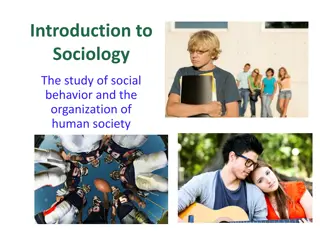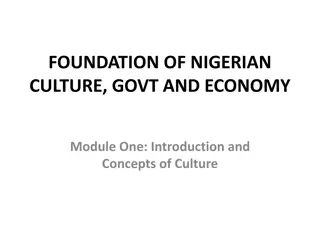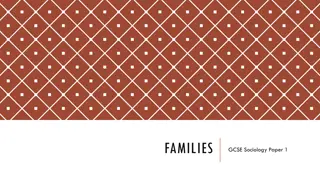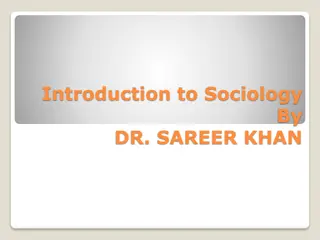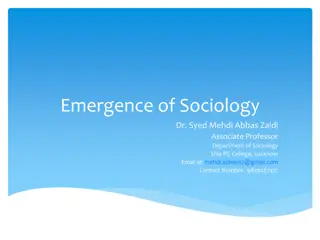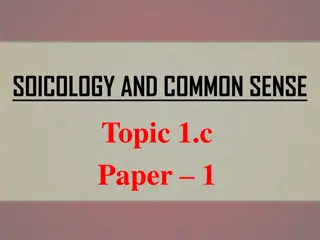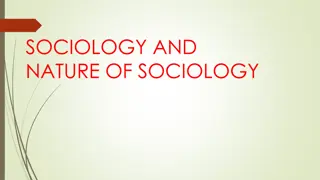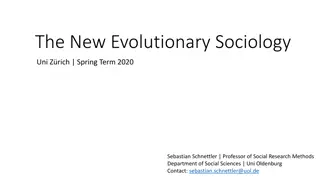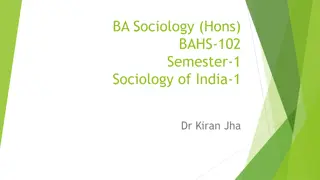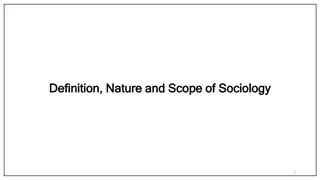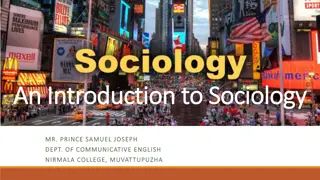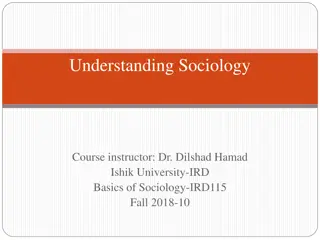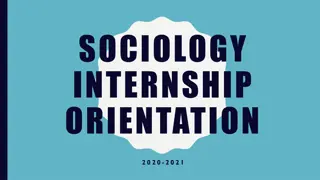Understanding Culture in Sociology: Key Concepts and Definitions
Culture is the cornerstone of society, distinguishing humans from animals and shaping our social lives. Sociologists define culture as the shared values, practices, norms, and beliefs that govern our interactions and behaviors. This comprehensive guide explores the non-material aspects of culture, including language, symbols, and social norms. Definitions by scholars such as Horton, Hunt, Taylor, and Herskovits offer insights into the diverse dimensions of culture. Discover the characteristics of culture, highlighting its social nature and the importance of learning and sharing it within a society.
Download Presentation

Please find below an Image/Link to download the presentation.
The content on the website is provided AS IS for your information and personal use only. It may not be sold, licensed, or shared on other websites without obtaining consent from the author. Download presentation by click this link. If you encounter any issues during the download, it is possible that the publisher has removed the file from their server.
E N D
Presentation Transcript
INTRODUCTION TO SOCIOLOGY BY DR.SAREER KHAN
CHAPTER NO: 03 CULTURE
CULTURE What is culture Culture is the Centre of a society and without culture no society can even exist. It is the main difference between human beings and animals. It is a heritage transmitted from one generation to another. It includes all the ways and behaviors is social life. Man is born in the environment of culture, in which he seeks his way of behaving and acting in a given society. Your can also find out effects of ethnocentrism. Culture is one of the most important concepts within sociology because sociologists recognize that it plays a crucial role in our social lives. It is important for shaping social relationships, maintaining and challenging social order, determining how we make sense of the world and our place in it, and in shaping our everyday actions and experiences in society. It is composed of both non-material and material things.
In brief, sociologists define the non-material aspects of culture as the values and communication, and practices that are shared in common by a group of people. Expanding on these categories, culture is made up of our knowledge, common sense, assumptions, and expectations. It is also the rules, norms, laws, and morals that govern society; the words we use as well as how we speak and write them (what sociologists call "discourse"); and the symbols we use to express meaning, ideas, and concepts (like traffic signs and emojis, for example). Culture is also what we do and how we behave and perform (think theater and dance) beliefs, language and
DEFINITIONS OF CULTURE Horton and Hunt: Culture is everything which is socially shared and learned by the members of a society. Taylor It is that complex whole including beliefs, art, region, values, norms, ideas, law, taught, knowledge, custom and other capabilities acquired y a man as a member of a society. Herskovits: Man made of the Environment is called culture.
FEATURES & CHARACTERISTICS Some of the important characteristics of culture has been cited below. 1. Culture is learned Culture is not inherited biologically but it is leant socially by man in a society. It is not an inborn tendency but acquired by man from the association of others, e.g. drinking, eating, dressing, walking, behaving, reading are all learnt by man. 2. Culture is social It is not an individual phenomena but it is the product of society. It develops in the society through social interaction. It is shared by the man of society No man can acquire it without the association of others. Man is man only among men. It helps to develop qualities of human beings in a social environment. Deprivation of a man from his company is the deprivation of human qualities.
3. Culture is shared Culture is something shared. It is nothing that an individual can passes but shared by common people of a territory. For example, customs, traditions, values, beliefs are all shared by man in a social situation. These beliefs and practices are adopted by all equally. 4. Culture is transmitted Culture is capable of transmitted from one generation to the next. Parents papas cultural traits to their children and in return they pass to their children and son on. It is not transmitted through genes Language is means to communication which passes cultural traits from one generation to another. but through language.
5. Culture is continuous It is continuous process. It is like a stream which is flowing from one generation to another through centuries. Culture is the memory of human race. 6. Culture is accumulative Culture is not a matter of month or a year. It is the continuous process and adding new cultural traits. Many cultural traits are borrowed from out side and these absorbed in that culture which adopt it, as culture is accumulative and combines the suitable cultural traits.
7. Culture is integrated All the cultural aspects are inter-connected with each other. The development of culture is the integration of its various parts. For example, values system is interlinked with morality, customs, beliefs and religion. 8. Culture is changing It remains changing but not static. Cultural process undergoes changes. But with different speeds from society to society and generation to generation. 9. Culture varies from society to society Every society has its own culture and ways of behaving. It is not uniform every where but occurs differently in various societies. Every culture is unique in itself is a specific society. For example, values, customs, traditions, ideologies, religion, belief, practices are not similar but different in every society. However the ways of eating, drinking, speaking, greeting, dressing etc are differs from one social situation to another in the same time.
10. Culture is gratifying It is gratifying and provide all the opportunities for needs and desires satisfaction. These needs may be biological or social but It is responsible to satisfy it. Our needs are food, shelter, clothing and desires are status, fame, money, sex etc are all the examples which are fulfilled according to the cultural ways. In fact it is defined as the process through which human beings satisfy their need. 11. Linked with society Last but not the least one of the characteristics of culture that culture and society are one and the same. But if we say that these turn two are twin sister, it would not be wrong. Society is a composite of people and they interact each other through it. It is to bind the people within the society.
TYPES OF CULTURE Material Culture (Physical) Material culture consists of man-made objects such as furniture, automobiles, buildings, dams, bridges, roads and in fact, the physical matter converted and used by man. It is closely related with the external, mechanical as well as useful objects. It includes, equipment like a railways engines, publication machines, a locomotive, a radio etc. It includes our financial institutions, policies etc. and referred to as civilization. technical and material parliaments, insurance
TYPES OF CULTURE Non-Material Culture (Symbolic) The term 'culture' when used in the ordinary sense, means non-material culture'. This term when used in the ordinary sense, means non-material. It is something nonphysical ideas which include values, beliefs, symbols, organization and institutions etc. Nonmaterial culture includes words we use, the language we speak, our belief held, values we cherish and all the ceremonies observed.
TYPES OF CULTURE Ideal Culture The culture which is presented as a pattern or precedent to the people is called ideal. It is the goal of the society. It can never be achieved fully because some part of it remains out of practice. It is explained in textbooks, our leaders speeches and guidance. The part of ideal culture practiced in social life is called real culture. Islam is our ideal one. We claim to be true Muslims and this claim is our ideal culture but how far we are Muslims in practice is our real culture. Both the real and ideal cultures are related together and different from each other.
TYPES OF CULTURE Real Culture Real culture can be observed in our social life. We act upon on culture in our social life is real, its part which the people adopt in their social life is their real one. The whole one is never real because a part of it remains without practice. How far we set upon Islam is our real culture. Being a Muslims, Christian and related to another religion we do not follow Islam, Christianity etc. fully in our social life. It means the part of religion which we follow is our real culture.
Cultural VARIABILTIES All the cultures in the universe are not the same and there are some differences on many elements and factors which occurs with passage of time in the shape of food, dress, Ceremonies, norms, values etc. Now the following variability's are given below in the following ways.
Cultural VARIABILTIES 1.Language Anthropologists wonder about the different manners and symbols through social interaction in spite of being Homo sapiens. Arabic is spoken in Arabia Sanskrit in India and there is great difference between their alphabets. Similar Chinese language in China and English in England has quite strong alphabets and it is difficult to think that the users of these languages spoke one language in any age. Times play a wonderful role in the change of social demands and social interaction of people, languages. For instance, in Indian Pakistan, Hindi or Urdu is spoken but one thousand years back, there was no concept language present here. : speaking different of this
Cultural VARIABILTIES 2.Dress To save individuals from physical environment and weather conditions, the use of dress is made in all cultures. Since, different cultures have been living in different weather conditions and physical environment, therefore, there is a difference of dress. In addition, customs and religious beliefs also affect the style of dress in terms of colour and design, In India Pakistan, because of hot weather and Islamic beliefs, light and cotton dress, covering the whole body, is used. Shalwar and shirt for men, Shalwar suit with head cover cloth (Dopatto) is used by women whereas in Switzerland because of very cold weather, people wear heavy woollen clothes consisting of coat, pantaloons, and hat or woollen cap. :
Cultural VARIABILTIES 3. Family System : According to Anthropologists, family structure is dependent on the economic sources like food and other biological needs availability. The more the sources, the more the size of family. For example, ancient nomadic tribe, societies and agrarian societies had an element of extended family as a part of culture, whereas in modern urban and industrial societies simple family culture is the popular family system. In addition, polygamy customs are different in different cultures. In India Pakistan, nikah and marriage feast are cultural traits, whereas in India, Bride and bridegroom take round around the fire and bojun distribution are customs.
Cultural VARIABILTIES 4.Religion Religion is an integral part of culture because the support of supernatural forces to decrease calamities has an integral part of human nature. The religion is, to get a spiritual relief by setting up, a connection with the real creator (God) and living in bring a revolution in a culture or to some culture and its transmission. That is why, that different culture has religions and beliefs. For instance, in Pakistan, with reference to Islam religion, individual of the society believes in Oneness of God and Prophethood of the Prophet Muhammad (Peace Be Upon Him) as the last. In India, several gods and Ram is thought as the apostle of God. In Japan, Muhatama Budhha is thought the redemption of humanity and is invoked for help and guidance : the danger natural idols are worshipped.
Cultural VARIABILTIES 5.Socialization All cultures change through education to convey the culture to next generation and to harmonize the individuals of the society with the manner of culture but this manner is different in different cultures. According to Mead: Cultural training teaches the individuals aggression competition and The variety of knowledge, observation play an important role in making the effects different. : or submission accommodation. experience or and
Cultural VARIABILTIES .Customs Every culture because of his individual festivals and beliefs has a manner or way of celebrating religious rites, effected by weather and society just as with the people of the Sub- continent, marriage is an important source of recreation and is a collection of many customs whereas in proposal or engagement, mehndi, barat, nikah, departure, marriage party and brides visit to parents after marriage are included. Drum beating, singing songs and such like recreations are also included. In Europe, a special acceptance of bridegroom for each other and invitation to a few friends at the occasion and expression of sorrow, coffin, burial or burning ways and arranging feast for people coming at the occasion and a collective prayer etc. are observed. : dress bride for marriage, and
Cultural VARIABILTIES 7.SocialNorms Social norms are bound by values, traditions and beliefs of a culture and their way is different because of different structures and expectations of different cultures. To say Salam is a Pakistani social norm, whereas there is used good morning to convey the same sense in European culture. Similarly, in Pakistani society, not drinking wine is a mores whereas in European culture this is not a mores. Left hand driving is lawful but in Saudi Arabia it is unlawful. :
Cultural VARIABILTIES 8. Rituals and ceremonies are an important source of transmission of culture and providing relief to the society because the passion of participating in them impresses on the minds, the effects of culture. There are different rites because of belief about nature and natural phenomena just as, in Pakistan, because of Islamic attachment; Eids, Miraj-an-Nabi and Mellad Sharif rites are observed. celebrations for, Pakistan Day and Quaid-i-Azam Day are held as rites. In India, Holly, Dewali, Basant and Independence Day while in England Good Friday , Christmas and Easter are celebrated as rituals. Rituals and Ceremonies : Under social views,
Cultural VARIABILTIES .Literature Literature and Arts is an important source of keeping remembered the epic and romantic incidents, occurring in a culture and also to transmit them to next generation. Art is an expression of pride and skill of individuals of a society but every culture has different experiences and observations. That is why, the manner and way is different in every culture. Just as, in Pakistani culture, Heer Ranja, Sussi Punnu; in Iranian culture, Sheren Farhad; in Arabian culture, Lailu Majnon etc. are topics of arts and poetry. Bungra, Luddi and Dance are part of Pakistani culture and Brake Dance and Pop Songs are part of European culture. and Arts :
Cultural VARIABILTIES 10. Sports and Recreations : Sports and recreations keep the individuals a society healthy and full of thrills and are a part of culture. However, because of this tendency of the individuals of a society and difference of environment, different cultures have i different plays, games and sports. In Pakistan, besides Kabaddi, Football, Volley ball, Cricket and Fairs, Urs, Circus, Cinema, Television and Theater are popular sports. In Arabian culture, Horse race, Camel race and Shooting arrows are popular whereas in European culture, there are Football, Car rallies, Motor sports, Clubs and Cinema are popular sports and recreations.
Cultural VARIABILTIES 11.Economic Economic determine the economic activities of a culture of a society. The activities according to economy of the society. A society depending upon agriculture economy is called an agrarian society. A society industrial economy is called an industrial society. Pakistan is an agricultural country with fertile land and with canal system with plenty of water whereas Japan is an industrial country with no land for agriculture but with industry chances. Activities natural : sources and environment of-the individuals are depending upon
Cultural VARIABILTIES 12.PoliticalSystem Wherever man has been (from nomadic society to industrial society), political system has been a part of its culture. They fought fights and died for it. However, the political system while going through stages of evolution has been different in structure in different cultures. In Saudi Arabic. Monarchy; in Libya, a dictatorship, in Britain, democracy; and in America democratic president-ship is current. :
Cultural Ethnocentrism Definition of Ethnocentrism Ethnocentrism defined as "a belief that one's own group, race, society and culture is good, normal, right and superior to other groups, culture, society and race that are inferior, wrong, abnormal and bad." There is a tendency in to judge other cultures, societies, groups, and races from one's own standards. Another words the people who consider their culture as supreme culture of the world and the other cultures are inferior to them is called cultural ethnocentrism.
Cultural Xenocentrism The term Xenocentrism is adopted from a Greek word Xeno (pronounced as ZEE-no) which means foreign guest or stranger . Xenocentrism sociological term ethnocentrism. ethnocentrism is the phenomenon, when people consider their culture superior compare to other culture. On the other hand, Xenocentrism is the feeling when people consider their culture inferior compare to other culture, and prefer to follow the elements or components of other culture rather than their own. For example if a tourist or a foreign exchange student returns home from abroad after a few months or years, and find it difficult to associate with his own culture, after experiencing the foreign culture and consider the foreign cultural norms, values and beliefs more upright compare to his own culture, this phenomenon will come under the fold of Xenocentrism. is the As opposite described of earlier; the
Cultural Lag When there is progress change in the rate of material and non-material culture in any society is called cultural lag. If the material cultural is increasing rapidly while the non-material culture remains constant or it is just decreasing. E.g the people are building masjid in pakistan but very low number of people come to masjid for offering prayers.




